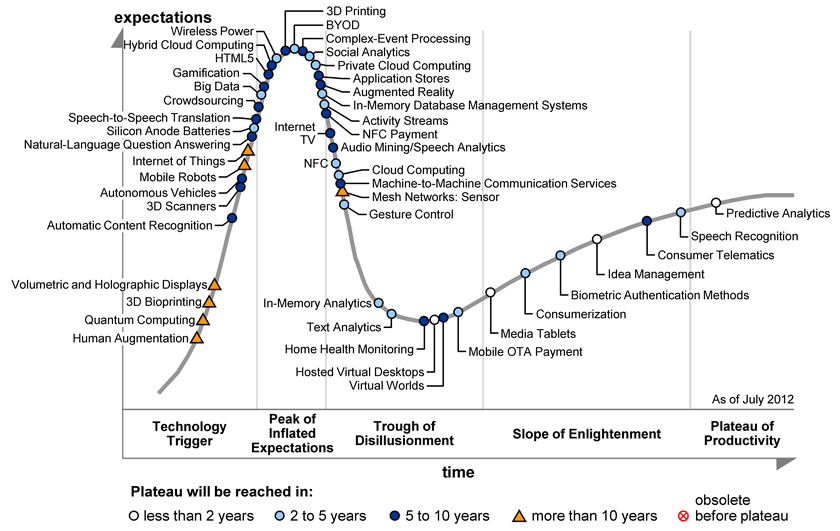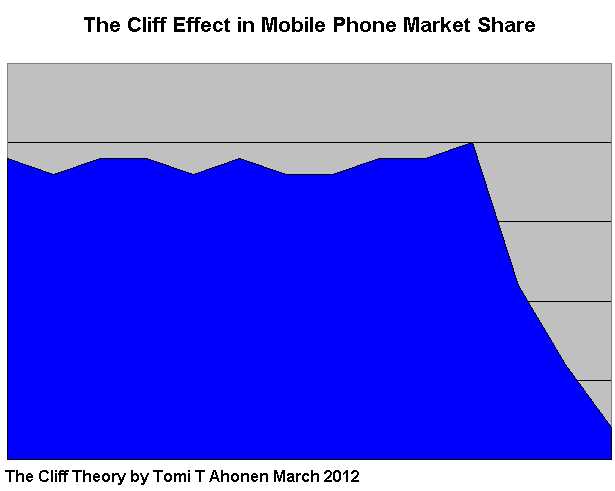Notes from Bruce Sterling’s opening talk at the Ontario Augmented Reality Network’s 2012 conference last week (5 October 2012). This is pretty much just what I took down while he was talking, and it doesn’t do justice to the talk. The third last paragraph here is a rude summary of some powerfully worded and very insightful thoughts. For another summary, see Greg J. Smith’s OARN 2012—The Shape of AR to Come.
I’ve been reading Sterling for over twenty years now. It was great to finally see him in person, and he puts on a good show. Follow his blog Beyond the Beyond to keep up with everything he’s interested in, including a lot of AR.
Showed a point cloud portrait of himself. Students had “hot-wired a Kinect” to take a 3D portrait of him. Technological underpinnings of the image: a camera tied to a Kinect with rubber bands.
Two themes for his talk:
- registration
- lash-ups with clumsy rubber bands
“Awesome new aesthetic glitch-core thing going on.”
What’s AR? “Has an augie floating around on it.”
“I’m a big fan of Ronald Azuma.” Ronald Azuma defines AR as:
- combines the real and the virtual
- interactive in real time
- registered in 3D
Showed a slide of companies involved in the AR Consortium in 2009, and ones involved now. They’re doing stuff that is sort-of kind-of registered. GPS registered, “within a couple of kilometers.” And there’s some kind of the real and the virtual, maybe just a signal, an icon, nothing too elaborate. Not a virtuality that’s so accurate it looks real. It’s interactive in real time, but not all that interactive. So all this stuff doesn’t meet the Azuma standard.
Showed the 2012 Gartner hype cycle for emerging technology. Note augmented reality heading from the peak into the trough.

“Lovin’ the Gartner hype cycle.” “On the SLOPE TO HELL. It’s all downhill from here.” “This is where we separate the men from the boys and the women from the permanent graduate students.”
What AR companies say now: “Please stop poisoning us with inflated SF-style expectations.” We do real useful work, with services, and don’t put us in the magic box. What they started off doing, where they thought they would go, turned out to be different, but they’re still getting along, surviving, working and doing interesting stuff. They haven’t gone under yet. Layar after four years decided that “it’s about interactive paper.” Value-add to Dutch magazines. That’s what pays them.
“I"m a journalist. I never say it’s true unless two guys lie to me about it.”
Tonchidot. Ydreams, Portuguese, does installations in e.g. banks. Not what you’d have expected an AR thing to be.
Mobile software applications. Consumer visual applications. Calling it AR gets in the way.
Though the 2009 companies (on AR Consortium list) haven’t broken out to mass appeal, they’re all still around. That’s good. They’re still getting by.
“It’s all about this guy: the head-mounted display.” Purpose-built, fully registered AR devices. Showed a picture of a helmet in a NASA museum. “In my sci-fi stories it’s all about the headmounts.”
Tomi Ahonen. Guru of Layar. Ex-Nokia; mobile business analyst. “You can’t be in the mobile software industry and not read this guy.” Nokia’s failure: “It’s epic. Tolstoy would be beggared.”
Never been a mobile phone purposely built for AR. No range finders. GPS is global-scale. Phones are about SMS. That’s where the cash in.
The Cliff Effect in Mobile Phone Market Share, from Tomi Ahonen.

Nokia, Motorola, RIM, others, went off this cliff. There aren’t other industries where this cliff happens. They have tons of money, lots of customers, why does this happen? Replacement cycle? Dealerships change their minds about what they want to sell. Carriers are evil. The carriers cut Microsoft’s throat because they bought Skype; now no-one will carry Windows Mobile.
Layar did an augmented reality hype cycle. Layar’s doing markerless AR with image recognition. They’re installing videos in magazines.
“Mobile is everywhere and the boundaries are breaking everywhere. Society won’t wait when it comes to lashing the real and the augmented together.”
First example of AR malware. PlaceRaider. Take over guy’s cell phone, turn on camera, build 3D augmentation of his room, look around to see if there’s anything worth taking. Augmented spyware. Don’t look at all the pictures, build them into an augmentation, then use it for spying.
“It’s a coming of age when the criminal underground starts exploiting your technology. Probably got a couple of criminals in the audience today.”
Leap Motion is making the Leap. About the Leap says, “Leap represents an entirely new way to interact with your computers. It’s more accurate than a mouse, as reliable as a keyboard and more sensitive than a touchscreen. For the first time, you can control a computer in three dimensions with your natural hand and finger movements.” Gesture recognition on a millimeter scale. Couple of orders more detailed than a Kinect. (Web site says it will ship in February 2013.)
Google Glass isn’t AR, it’s a heads-up display. Doesn’t really augment. It’s an Android that isn’t handheld and responds to voice commands.
Intel’s perceptual computing. Intel wants desktop computing to keep going. Perceptual computing, voice recognition, augment the room. How do we get heavy iron on the desktop? Jazz up the space.
AR has always been piggybacking on other hardware, but now that things are breaking down, maybe AR can find a place in a gap there. Facebook, Google, Microsoft, all those things we spend our time in, they’re doomed. They’re all headed for the Ahonen cliff. Apple too—“beset with hubris.”
What does the AR victory condition look like? Submillimeter recognition. Then you’re just in a space doing things and the augments carry out your will. The ultimate AR experience is made out of AR. You’re in the space having experiences that lead you to other experiences. In a space, in a sea, where registration rules. The primary design effort is experience. What does it look like, what does it feel like, what does it do. A world where augmentation is in power. It’s not going to take power through any of the OSes or systems we have today, but that isn’t a problem … they’re not going to last. Reached a condition of volcanic instability.
There is something ahead of all this that’s hard to imagine, as hard to imagine for us as for people back in the fifties.
Final advice: Read Tomi Ahonen.
 Miskatonic University Press
Miskatonic University Press
